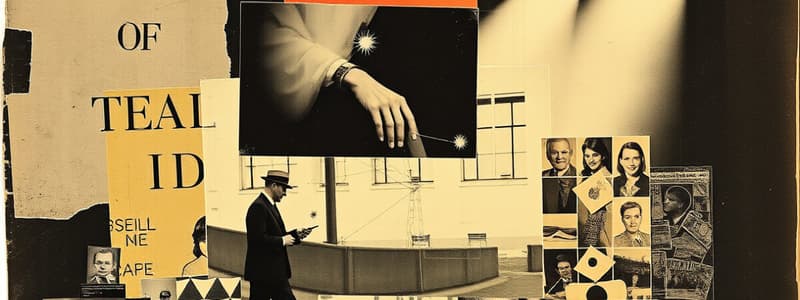Podcast
Questions and Answers
What is the definition of a dramatic effect?
What is the definition of a dramatic effect?
- Used to create drama, tension, and emotion (correct)
- Used to create comedy and humor
- Used to simplify complex themes
- Used to enhance visual elements
What does dialogue reveal?
What does dialogue reveal?
Thoughts and feelings of characters
What are stage directions?
What are stage directions?
Instructions in the script for actors' movements and behaviors
What is symbolism?
What is symbolism?
Define a monologue.
Define a monologue.
What is a soliloquy?
What is a soliloquy?
What is irony?
What is irony?
What does foreshadowing entail?
What does foreshadowing entail?
Define dramatic irony.
Define dramatic irony.
What is an aside?
What is an aside?
What is a paradox?
What is a paradox?
Flashcards are hidden until you start studying
Study Notes
Dramatic Devices and Their Functions
- Dramatic effect: Utilizes techniques to enhance drama, tension, and emotional resonance while conveying themes and messages effectively.
- Dialogue: Interactive communication between characters that unveils their thoughts, feelings, and relationships, driving the story forward.
Structural Elements of Drama
- Stage directions: Essential script instructions that guide actors on movement and behaviors, providing clarity for performance and audience understanding.
- Symbolism: Incorporates objects, actions, or characters as representations of larger ideas, enriching the narrative with deeper meaning.
Character Expression Techniques
- Monologue: Extended speech by a single character, showcasing their internal thoughts and reflections, allowing for character development.
- Soliloquy: Similar to a monologue, but specifically involves a character speaking their thoughts out loud to themselves or the audience, adding emotional depth.
Tension and Anticipation in Drama
- Irony: A literary device where the outcome contrasts with expectations, used strategically to create dramatic tension and engage the audience.
- Foreshadowing: The technique of embedding hints or clues within the narrative that suggest future plot developments, building anticipation.
Audience Engagement Techniques
- Dramatic irony: A situation in which the audience possesses knowledge that the characters lack, creating tension and emotional investment in the unfolding events.
- Aside: A character's comment directed at the audience, meant to be heard by them but not by other characters, providing insight into thoughts or motivations.
Complexities in Character and Plot
- Paradox: A statement or situation that appears self-contradictory but reveals a deeper truth, prompting reflection and deeper understanding of the narrative.
Studying That Suits You
Use AI to generate personalized quizzes and flashcards to suit your learning preferences.



